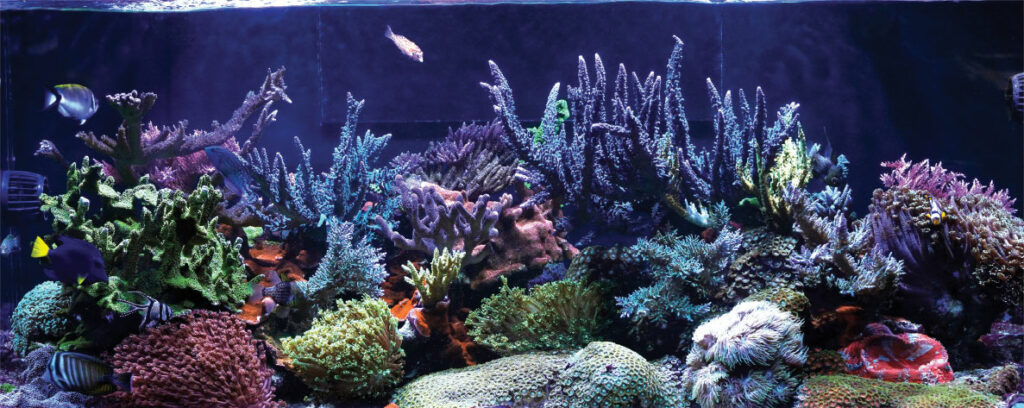
SPECIAL NOTE! Join ReefBum’s Keith Berkelhamer and CORAL editor Matt Pedersen for an exclusive live Q&A session on December 2nd, 2022, at 7 p.m. Eastern!
You can submit questions in the comments below, email them to matt.pedersen@reef2rainforest.com, or ask them directly during the live event! The live stream will be held on the ReefBum YouTube Channel at https://www.youtube.com/watch?v=5bzWjBeKBuY – go there now and click “Set Reminder” so you don’t miss out! We’ll even have some special giveaways during the event!
CLICK HERE for more details and an earlier video of Berkelhamer and Pedersen from February 2021.
AQUARIUM PORTRAIT from the November/December 2021 issue of CORAL Magazine
When people ask me what I do for a living, I sometimes say I am a farmer—not an unusual occupation in rural northern New England in a state whose best-known exports are maple syrup, cheddar cheese, and Ben & Jerry’s ice cream. However, you should see the quizzical looks I get when I add that what I grow are corals. A coral farm in Vermont?
I live in the Mad River Valley, an area with two well-known ski areas, covered bridges, beautiful mountain vistas, swimming holes, numerous hiking trails, and several working farms. It is quintessential Vermont. Yes, I am an outlier since reefkeepers are rare in a sparsely populated state that was once known to have more sheep than people.
I decided to start this reef tank soon after my wife and I moved to Vermont seven years ago, with me leaving behind a full-time career in media and marketing research in New York. I was trading a four-hour daily commute for a place in the mountains and a chance to escape a corporate life that was taking its toll, while indulging my desire to achieve a better work/life balance and become a bit more of a ski bum. Once settled, I soon acquired a 5-foot-wide, 187-gallon (708-L), Euro-braced glass tank built by Coast to Coast Custom Aquariums.
Early Struggles
I have been keeping reef tanks for about 27 years, so it is safe to say I have a love affair with the hobby. It is in my blood. I thought I knew what I was doing, but it was a struggle for the first two years. The aquarium seemed to be hit by one plague after another. I had had a lot of success keeping reefs before the move, so the problems were disheartening.
At several points I wondered whether there was something in the Vermont well water preventing me from having success. Were impurities getting past my RO/DI filter? Was there some other intangible I wasn’t thinking about? Maybe that is why folks don’t keep reefs around here? Silly thoughts for sure, but I was reaching for answers.
Ultimately, I came to believe that the issues were due to the dry rock I used to start the tank. I had always aquascaped tanks with live rock, but live rock had become much harder to find. The dry rock option appealed to me, since the odds of importing pests were much lower versus live rock. You could also take your time crafting a cool, unique aquascape with dry rock out of the water.
Well, I moved forward with dry rock and soon had problems I never encountered before with my live-rock-only tanks. I just couldn’t grow SPS like I had in the past. First it was a bacteria bloom, and then I had a bad case of diatoms. I even had a bad outbreak of cyanobacteria.
The biggest problem turned out to be dinoflagellates: brown, snotty infestations (similar to cyanobacteria) coating the substrates. I tried everything (three-day blackout, hydrogen peroxide, Vibrant), and my corals took a beating. It finally caused me to break the tank down completely after two years and throw out the dry rock and live sand. In retrospect, I should have added more bacteria and biodiversity, such as sponges and microfauna, when I started with dry rock. I later added a UV sterilizer and think I should have done it sooner.
After I broke the tank down, I let it sit for a few weeks. I went down to Florida on vacation for several days and decided to track down some live rock to restart the tank. I sure the heck was not going to find any in the mountains of Vermont.
I found a local fish store (LFS) that had Haitian live rock. This type of rock is awesome because it has many nooks and crannies, as well as flat shelf pieces that are great for planting frags. The LFS said it was getting in a new shipment during my vacation, so I was very excited to cherry-pick some pieces. When I arrived, I knew I had hit the motherlode. I picked out 127 pounds (about 60 kg) of rock, which were packed into four Styrofoam boxes for my flight home later that day. When I showed up at the airport, I was told it would cost over $400 to transport the rocks on the plane.
This was way higher than the estimate I was given over the phone. Luckily, the airline folks were able to cut the cost in half by packing the rocks in two larger boxes. Still not cheap—but I was not going to leave the rocks at the airport.
I added the Haitian live rock 4.5 years ago and the tank has essentially thrived since then, with a few bumps in the road.
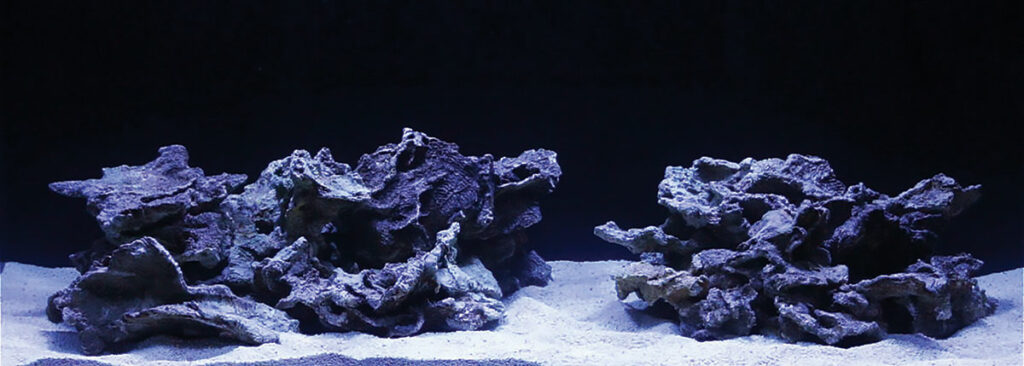
Simplicity & Stability
I believe in simplicity when keeping a reef tank. I try to minimize points of failure, so I do not like to have a lot of equipment and many moving parts. I use a GHL Profilux 4 controller, but it serves more as a monitor. Things like automatic water changes scare me, since disaster can strike if the automation fails.
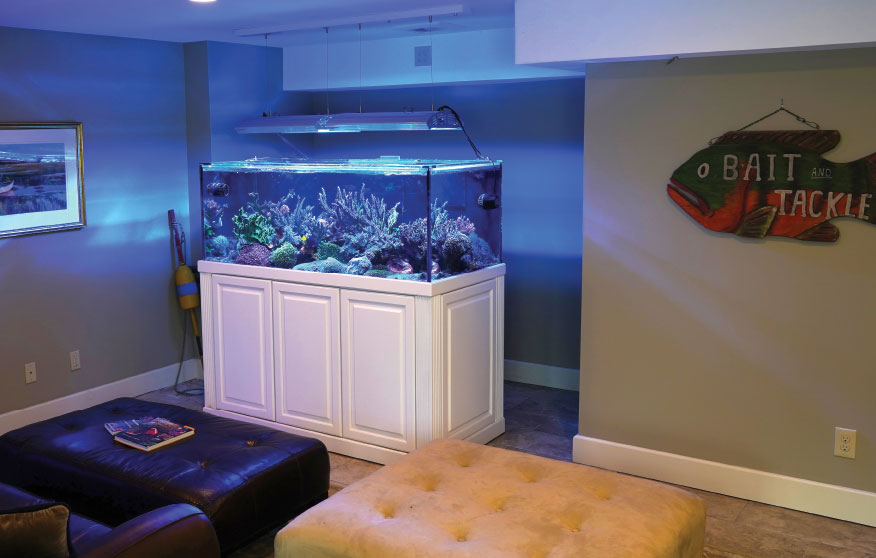
I have an alkalinity monitor, a GHL KH Director, but I do not use the control function. I monitor dKH levels and make any adjustments myself. The control function can be disabled on these units if a dKH reading falls out of a specified range, but I still prefer to do the fine-tuning myself.
I also think it is critical to have stability for parameters such as salinity, nitrate, magnesium, and calcium. Stable phosphate is important as well, but perhaps most important in my book for SPS is keeping alkalinity at a consistent level. This is why I invested in the alkalinity monitor. When this parameter swings over a short period of time, it usually spells trouble. Stable parameters result in happy SPS.
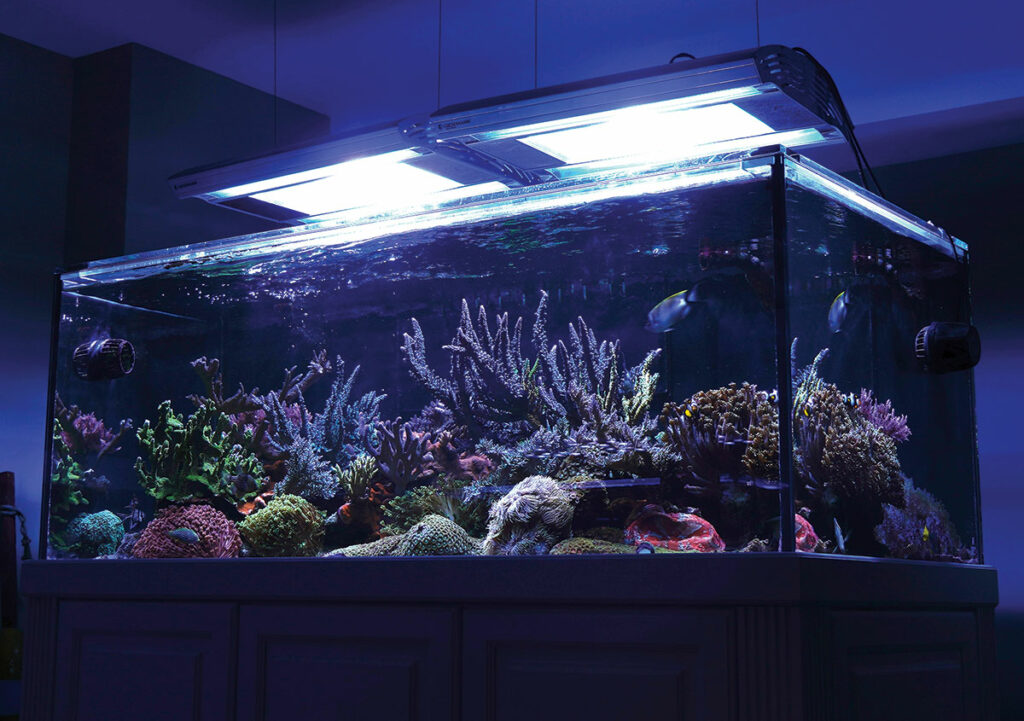
Success with Halides
Over the years I have achieved great color and growth with SPS corals by using metal halides (400W 20K Radium bulbs) and T5s. I know many have had success using LEDs. I did consider them but decided to stick with halides for this tank. Yes, old-school all the way. One side note: I have taken the plunge with LEDs on my new peninsula tank, so it is possible to teach old dogs new tricks.
Calcium and Alkalinity Supplementation
A strong calcium and alkalinity supplementation system has been another key to my success. When I rebooted the tank, I used ESV B-Ionic two-part solutions to supplement calcium and alkalinity. This worked great, because it allowed for precise dosing of each component, and it provided important major and minor trace elements for corals.
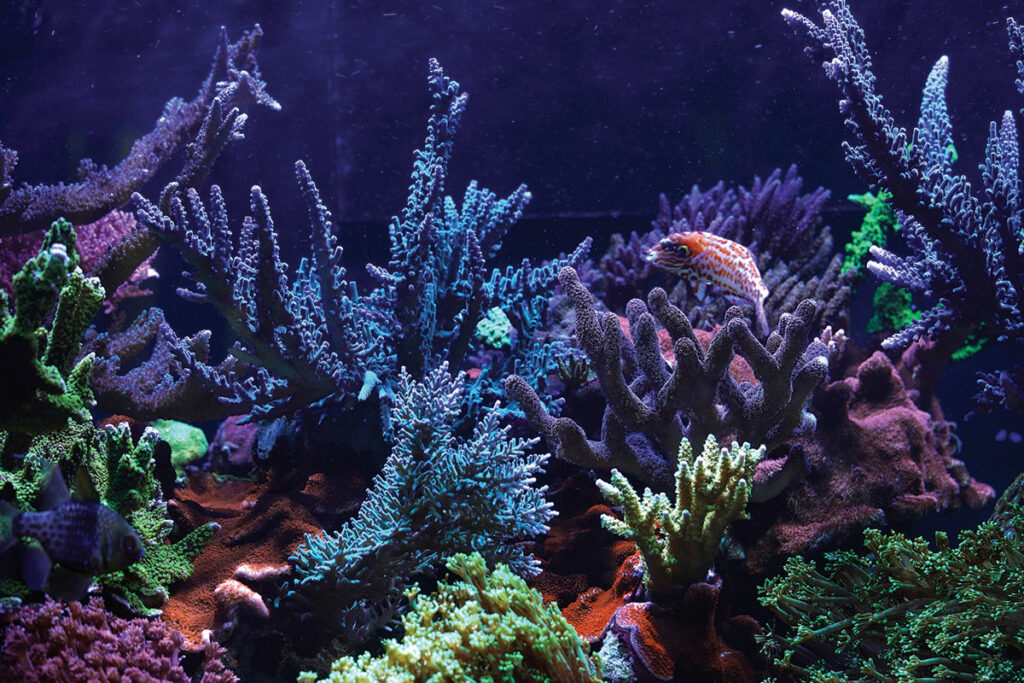
Using a two-part dosing system also kept my pH elevated versus using a calcium reactor. With a calcium reactor, carbon dioxide is injected into the reactor to lower pH to help dissolve calcium-based media inside. This calcium-rich liquid or effluent is then dripped back into the tank and will lower the pH of the entire system.
Anyway, as my corals grew so did the demand for the two-part solutions. It became pricey, as I was dosing up to 300 mls of each ESV component per day. At that point I decided to save money and make the switch to a calcium reactor. My only hesitation was the lower pH caused by a calcium reactor.
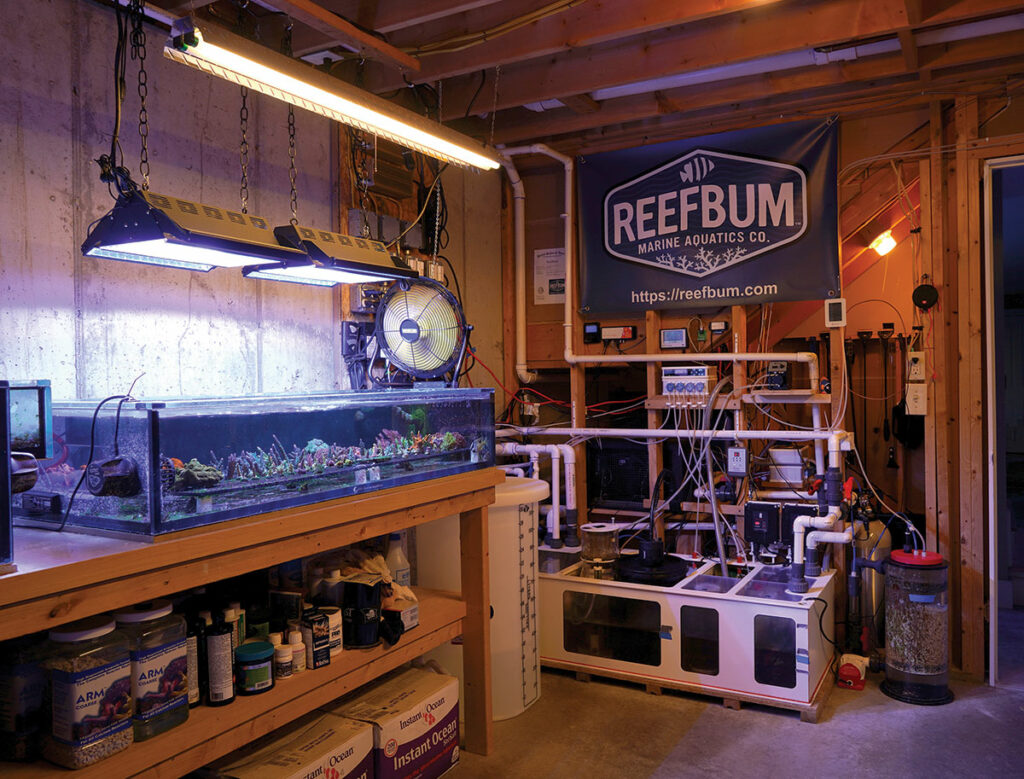
To compensate for the lower pH, I did a few things. One was to drip the calcium reactor’s effluent into the pump feeding the protein skimmer. This helped to degas the CO2 in the effluent, as there is a lot of air exchange occurring inside a skimmer.
I also used kalkwasser to boost pH. Hydroxide ions in the kalkwasser use carbon dioxide to increase alkalinity and, as a result, removes excess CO2 and increases pH. My kalkwasser is kept in a 30-gallon drum filled with RO/DI water. 3,600 mls of this saturated solution is dosed daily to the tank via two peristaltic dosing pumps. I got the idea to use the drum from Chris Meckley at ACI Aquaculture, where he has had great results with this method. I wanted to replicate his success.
The dosing occurs when the display tank lights are off to compensate for the lower pH during this time. I do not stir the solution. The only time it is mixed is when the drum is refilled every two weeks with RO/DI water and kalkwasser. Every two months I replace the kalkwasser that has settled in the drum.
A key with this method is to make sure to add enough kalkwasser to super-saturate the solution. The way I determine this is by measuring the conductivity of the mixture. Saturated solutions have a conductivity around 10.3 mS/cm at 25° C. (http://reefkeeping.com/issues/2005-01/rhf/index.htm#10)
Besides raising pH, using kalkwasser also lightens the load for my calcium reactor, since it will not have to supply as much calcium and alkalinity. The result is less money spent on CO2 and reactor media.
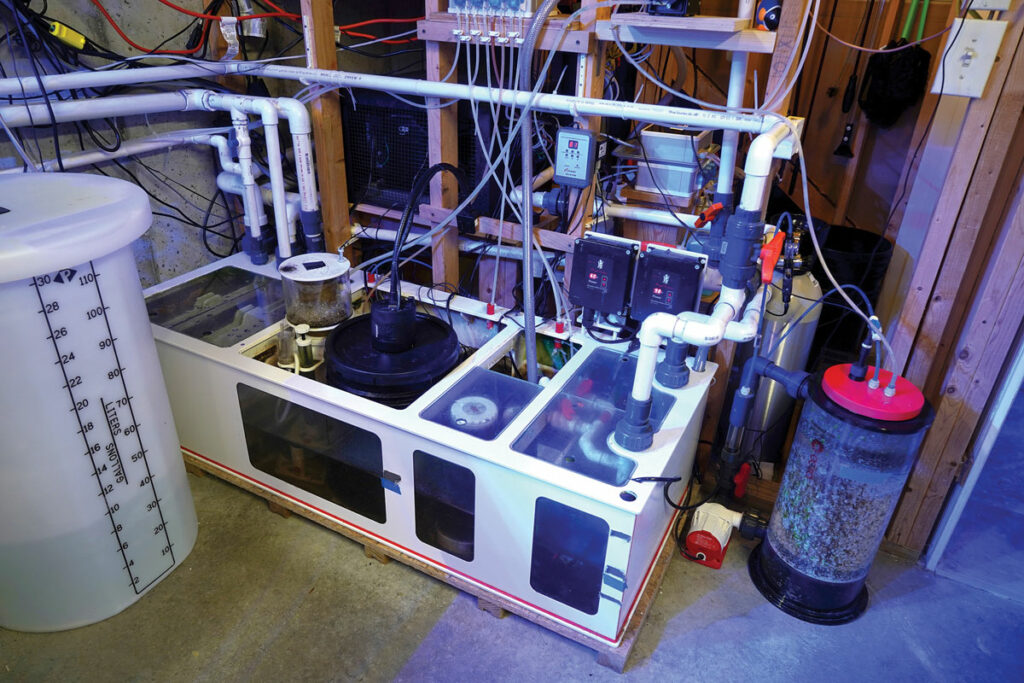
Boosting pH
pH was also elevated with an air exchange unit. My tank sits in a finished basement and the windows are shut tight in the winter. CO2 can build up and be absorbed by the tank.
After the air exchange unit was installed the tank’s pH rose by 0.2 pH points. This was significant since pH is measured on a logarithmic scale. Overall, the pH of the tank sits in the 8.1 to 8.4 range. Sometimes it climbs to 8.5. This range is higher compared to when I was using the two-part calcium/buffer solutions. I have seen a growth spurt with my SPS since switching to the calcium reactor/kalkwasser method. A higher pH seemed to make a difference.
As for my dKH, I like to keep it in the 8.5 to 9.0 range. I don’t worry too much about calcium, which is usually between 410 and 440 ppm. Magnesium sits in the 1400 to 1440 ppm range.
Circulation
I believe that good water flow has been another key to my success. Strong flow helps to keep detritus from collecting at the bottom, preventing nitrates and phosphates from building up in the tank.
Strong circulation also helps to deliver food and nutrients to corals and helps to prevent problematic algae from taking hold in the tank. Additionally, good circulation creates surface agitation, which increases oxygen levels, and the glitter effects replicate the light refraction seen in our natural reefs.
Two 100W Royal Exclusiv Red Dragon return pumps in my sump generate a good amount of flow in the tank. The return pumps are supplemented by three Ecotech MP40s inside the tank. Those units are set on the short pulse mode to generate surge in the aquarium.
My target turnover rate is 40 to 60 gallons per hour. This is the number of times per hour the water volume in the display tank is moved, combining the flow from return pumps and internal circulation pumps. For my 187-gallon tank, I have about 10,000 GPH of flow. This equates to a turnover rate of 53X.
Nutrient Import/Export
Regarding nutrients, I like to run a high import/high export type of system and have measurable levels of nitrates (2.5–5 ppm) and phosphates (.03–.07). On the import side, I feed my fish a lot.
On the export side, I lean on regular water changes (10 percent weekly) for nutrient control and to replenish trace elements. I also rely on skimming and use Chaetomorpha (“spaghetti” macroalgae). I have grown Chaeto in both an algae reactor and a refugium, my current method. However, I am experimenting at this point with bacteria dosing to help manage nutrients and control problematic algae.
Hands-off Approach
What else has contributed to this tank’s success? I try not to tinker. Constantly dipping my hands in the tank to rearrange corals may cause problems, as I believe that oils from my skin can stress corals and fishes. In my experience, corals will also become stressed due to the frequent touching and handling. I like to sit back, relax, and let Mother Nature do her thing.
I also try to be patient with my tank. Nothing good happens to a reef tank when you act too quickly.
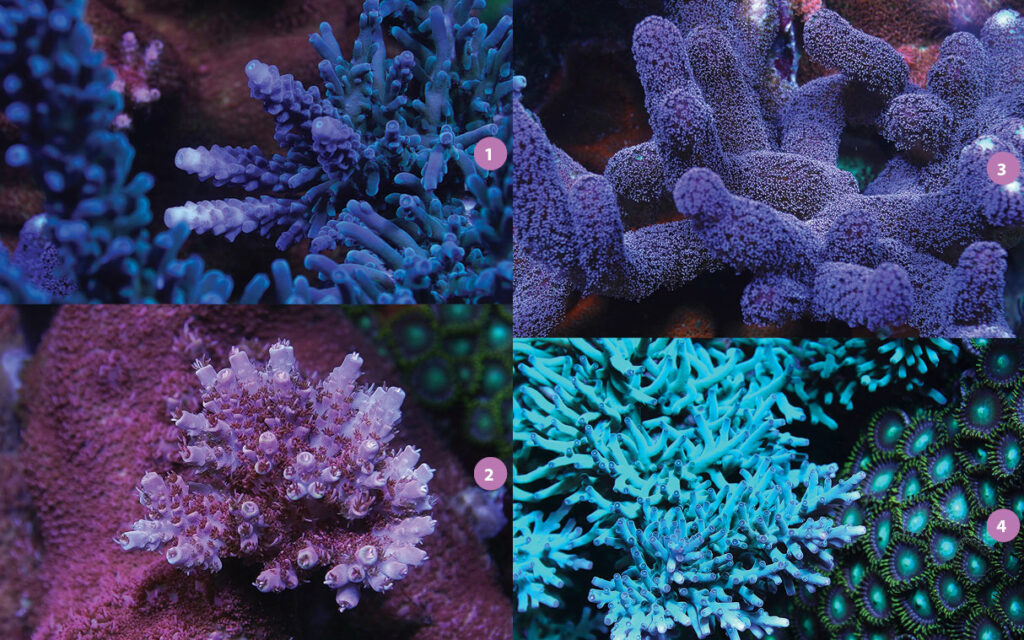
Maintenance
As I mentioned before, I do 10-percent weekly water changes with this tank, using Instant Ocean salt mix. During those water changes I siphon out as much detritus as possible. This is a critical step to keep nutrients in check.
I begin by siphoning out any detritus that has accumulated in my sump. I also siphon out detritus that has collected in the two frag tanks plumbed into the system. I use a powerhead on occasion to blow off any detritus in the display that has collected on the rocks.
The sand bed in the tank is left alone. I leave that maintenance for my clean-up crew of sea cucumbers, Peppermint Shrimp, snails, and hermit crabs. Three wrasses in the tank help to stir up the sand.
Every week I clean my filter socks and skimmer and wipe off any salt spray on my light fixtures. I also check my dosing tubes for any clogs. Every three weeks I re-calibrate the two pH probes on my controller. One monitors pH for the tank and the other keeps track of pH inside my calcium reactor. I also re-calibrate the pH probe on my KH Director. On a monthly basis I swap out my activated carbon.
One vitally important service I do every two months is to clean the dosing pump heads on my GHL dosers. Peristaltic pumps need constant maintenance to make sure they run at an optimal level.
Every three months I service my pumps, including the two return pumps, the skimmer pump, the pump that feeds the refugium and the MP40s. I disassemble the pumps and soak all the parts in a one-part vinegar and one-part water solution for 30 minutes. Everything is then scrubbed clean with brushes and rinsed in warm freshwater.
Another item on the maintenance to-do list is servicing my SpectraPure RO/DI unit. I religiously swap out the filter cartridges every six months. I also replace the membranes every two or three years.
Water Testing
In terms of testing, I monitor pH, temperature, and conductivity on a constant basis with my controller. dKH is measured twice a day, once during the overnight hours and a second time during the afternoon.
Every week I measure phosphate with a Milwaukee test kit while calcium, magnesium, and nitrate are measured via Salifert test kits.
The last thing I do is observe the tank. Daily observation is important to me so I can potentially spot trouble not detectable through regular testing. In the past I have had a coral or two that have acted like a canary in a coal mine, exhibiting earlier signs of stress versus other corals in the tank.
In this instance, I will usually order an ICP test to get a more detailed look at what is going on with the tank.
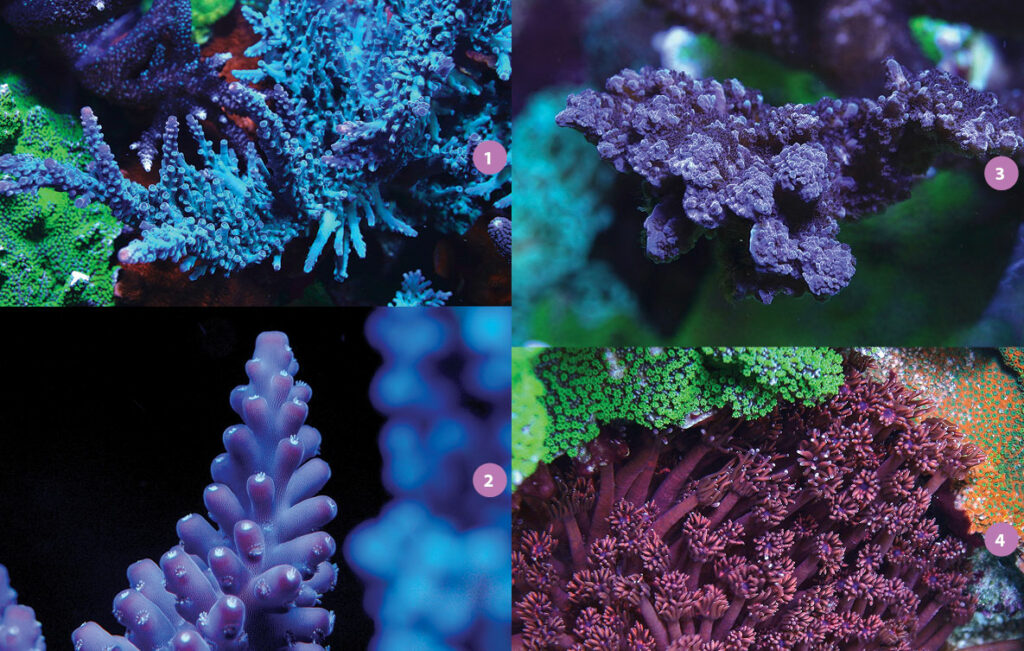
Supplements/Additives/Fish &Coral Food
I don’t go overboard with supplements and additives for this tank. I do dose nitrates and phosphates when necessary to maintain my target levels. I also dose ChaetoGro from Brightwell Aquatics to optimize macroalgae growth.
Over the years I have not used coral food or amino acids too often with my reef tanks. I did use frozen Cyclopeeze and Reef Nutrition’s Oyster Feast and Roti Feast pretty consistently with a previous 225-gallon tank. I have used Oyster Feast sparingly with this tank. (Today I tend to get cyanobacteria or some other type of undesirable algae like dinoflagelletes when I dose too much coral food or aminos.)
As for fish food, I usually feed Mysis and brine shrimp cubes, pellets as well as nori dried seaweed. My tangs need their veggies and just love the nori. My goal is to feed the fish four to five times per day.
I have also made my own coral and fish food. Ingredients include shrimp, scallops, nori, clams, mussels, silver sides, blood worms, Mysis, and brine shrimp. I also add in some Vitachem, Spirulina powder, garlic, and some Reef-Roids. Vitachem addresses nutritional deficiencies in marine fish and invertebrates. Garlic helps finicky fish eat, and the Spirulina powder is supposed to be good for fish, corals, and invertebrates, as it contains amino acids, vitamins, and minerals.
Personally, I have not noticed better color or growth with my corals after using aminos or coral food from a bottle. My corals seem to do pretty well without that stuff. I think fish poop is beneficial for corals—one reason why I like to keep my fish fat and happy.
Final Thoughts
At this point, the tank is doing very, very well. Coral growth is literally wall-to-wall. This is both a blessing and a curse. Too many corals can restrict flow, making it tougher to deliver nutrients to the corals. Some of the oversized colonies are also shading out other corals. In some places, there is recession at the bases of larger colonies due to a lack of light and flow.
Fragging the large colonies has helped, but the bases of many of these corals have grown together and started to choke each other out. The question is, should I be proactive and redo a mature reef that is currently flourishing? Am I insane for considering this? Or should I continue to frag large chunks off coral colonies?
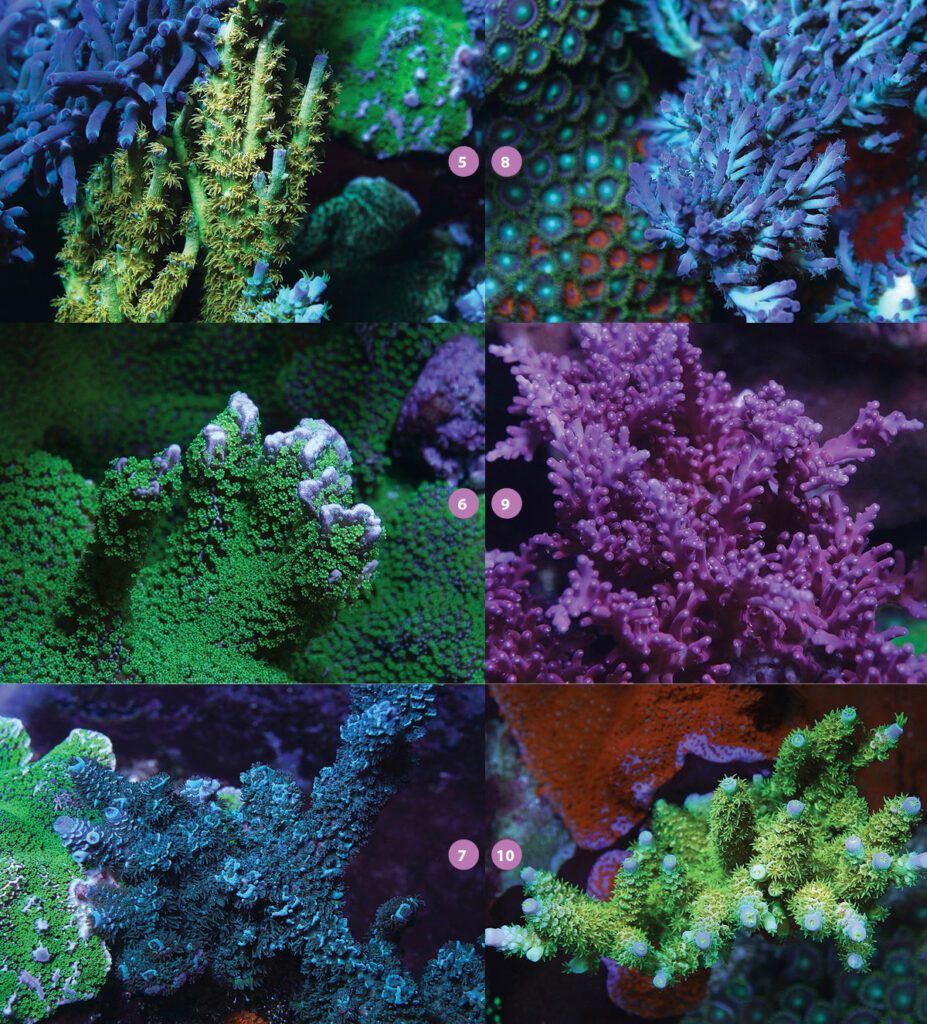
At some point the answer will become clear. But I will take my time to make a final decision. Since moving to the mountains, I may have become as much a reef bum as a ski bum, and I live by the old truism about slowing down and having patience: Nothing good happens quickly when it comes to reefkeeping.
Keith Berkelhamer is the author of A ReefBum’s Guide to Keeping an SPS Reef Tank: A Blueprint For Success (2017). He has been a reef tank hobbyist for nearly 30 years, winning Tank of the Month honors once from Reef2Reef, and twice from Reef Central. He chronicles his reef-keeping journey through his blog at ReefBum.com and the ReefBum YouTube channel.
ONLINE
https://www.youtube.com/c/ReefBum
https://www.reefbum.com
Aquarium Details
TANK SIZE AND TIME IN OPERATION:
MAIN AQUARIUM:
- Custom built by Coast to Coast Custom Aquariums
- 187-gallon (708-L) Euro-braced glass aquarium
- 60 in. L x 30 in. D x 24 in. H (150 x 76 x 60 cm)
- Starphire low-iron glass front and two end panels
- Painted black background
- 21 in. L external overflow box
- 36 in. H traditional style stand w/raised-panel doors, fluted trim moldings and water-resistant pan liner
75-gallon (284-l) frag tank:
- Custom built by Coast to Coast Custom Aquariums
- Euro-braced glass aquarium
- 60 in. L x 24 in. D x 12 in. H (150 x 60 x 30 cm)
- Starphire low-iron glass front and painted black background
- 12 in. L external overflow box
50-gallon (189-l) frag tank:
- Custom built by Coast to Coast Custom Aquariums
- Euro-braced glass aquarium
- 48 in. L x 24 in. D x 10 in. H (122 x 60 x 25 cm)
- Starphire low-iron glass front and painted
- black background
- 13 in. L (33 cm) external overflow box
Sump:
- Royal Exclusiv Dreambox
- 59 in. L x 23-1/2 in. W x 13-3/4 in. T (150 x 60 x 35 cm)
- 74-gallons (280-L)
- Filter socks: 3×800 micron, 3×400 micron, 4×200 micron
- Royal Exclusiv Dreambox 2 Liter Media Reactor (activated carbon)
- LED lighting
TOTAL SYSTEM VOLUME: 386 gallons (1,461 L)
TIME IN OPERATION: System started in July 2015. Re-started in April 2017 and has been in operation for 4.5 years.
AQUASCAPING/SUBSTRATES:
- 127 lbs (58 kg) of Haitian live rock
- 100 lbs (45 kg) Tropic Eden Live Reeflakes Sand
SKIMMER:
- Deltec SC 1456 internal protein skimmer
CIRCULATION:
- (2) Red Dragon 3 Speedy 100W return pumps
- (3) Ecotech Marine Vortech MP40wQD circulation pumps (187-gallon display)
- (2) Ecotech Marine Vortech MP40wQD circulation pumps (75-gallon frag tank)
- (1) Ecotech Marine Vortech MP40wQD circulation pump (50-gallon frag tank)
- (1) Maxspect XF350 Gyre Pump & Controller (50-gallon frag tank)
LIGHTING:
187-gallon (708-l) main display aquarium:
- (2) Giesemann Spectra 24 in. (61 cm) fixtures,1 x Mogul, 4 x 24w T5s
- (2) LuXcore 400w Selectable Wattage Electronic Ballast: settings include250w, 250w HQI, 400w, 400w Super Lumens
- (2) 400w 20K Radium bulbs driven on 400w Super Lumens setting
- (4) Giesemann 24 in. 24w PowerChrome Midday T5s
- (4) Giesemann 24 in. 24w PowerChrome Actinic Blue T5s
75-gallon frag tank:
- (2) Lumenarc reflectors
- (2) LuXcore 400w Selectable Dimmable Ballast: settings: 250w, 250w HQI, 400w, 400w Super Lumens
- (2) 400w 20K Radium bulbs driven on 400w Super Lumens setting
50-gallon frag tank:
• (2) Reef Brite Halide Hybrid 15 in. SE Pendants with XHO LED strips—400W
• (2) Reef Brite 400W Metal Halide Electronic Ballasts
• (2) 400w 20K Radium bulbs
REFUGIUM:
- DIY bucket refugium
- Kessil H380 Spectral Halo II light
CALCIUM/ALKALINITY SUPPLEMENTATION:
- Reef Octopus VarioS CR220 9-inch calcium reactor
- VarioS 6 variable speed pump
- Kamoer FX-STP WiFi Continuous-Duty Peristaltic Dosing Pump
- Two Little Fishies Reborn calcium reactor media
- 30-gallon (114-L) drum for kalkwasser
- ESV Calcium Hydroxide (kalkwasser powder)
CONTROLLERS/MONITORS/DOSERS:
- GHL Profilux 4 controller
- (2) GHL Leak Sensors
- GHL KH Director
- (2) GHL Doser 2.1
RO/DI:
- SpectraPure 180 gpd (680-L/day) MaxCap RO/DI System with manual flush valve
COOLING:
- Tradewind Super 1/2 HP Inline Chiller
- (2) Master MAC-12F 12 in. floor fans (for frag tanks)
HEATER:
- Finnex TH-0800S titanium heater, 800W
- Finnex HC-0810M digital heater controller
UV STERILIZER:
- Aqua Ultraviolet 57-Watt Classic UV Sterilizer
AUTO TOP-OFF:
- SpectraPure Ultra-Precise Level Controller UPLC-II
WATER PARAMETERS:
- Alkalinity: 8.5–9.0 dKH
- Calcium: 410–430 ppm
- Magnesium: 1,400–1440 ppm
- Salinity: 32–33 ppt
- Temperature range: 77–81° F (25–27.2° C)
- Nitrate: 2.5–5 ppm
- Phosphate: .02–.05 ppm
LIVESTOCK:
Fishes in the 187-gallon (708-l) display
- 1 x Japanese Masked Swallowtail Angelfish, Genicanthus semifasciatus
- 1 x Flame Hawkfish (“Burt”), Neocirrhites armatus
- 1 x Purple Tang, Zebrasoma xanthurum
- 1 x Yellow Tang, Zebrasoma flavescens
- 1 x Desjardini Sailfin Tang, Zebrasoma desjardinii
- 2 x Black Onyx Picasso Clownfish (mated pair), Amphiprion percula
- 1 x Black Spotted Leopard Wrasse, Macropharyngodon meleagris
- 1 x African Leopard Wrasse, Macropharyngodon bipartitus
- 1 x Choati wrasse, Macropharyngodon choati
- 2 x Pajama Cardinalfish, Sphaeramia nematoptera
- 1 x Banggai Cardinalfish, Pterapogon kauderni
Corals
- 40 x Acropora spp. Including A. millepora, A. austera, A. echinata, A. florida, A. hyacinthus, A. microclados, A. sarmentosa, A. secale, A. tenuis, A. tortuosa, A. turaki
- 7 x Montipora spp.
- 2 x Stylophora spp.
- 1 x Acanthastrea sp.
- 1 x Branching Hammer, Euphyllia ancora
- 1 x Duncan Coral, Duncanopsammia axifuga
- 3 x Goniopora
- 2 types of Zoanthids (Zoantharia)
- 1 x Blue Ricordea colony, Ricordea florida
Invertebrates
- Trochus snails
- Astrea snails
- Tigertail Sea Cucumbers, Holothuria sp.
- Blue Leg Hermit Crabs, Clibanarius tricolor
- Nassarius snails
- Peppermint Shrimp, Lysmata sp.
OWNER:
Keith Berkelhamer
Warren, Vermont
ReefBum Marine Aquatics
https://reefbum.com
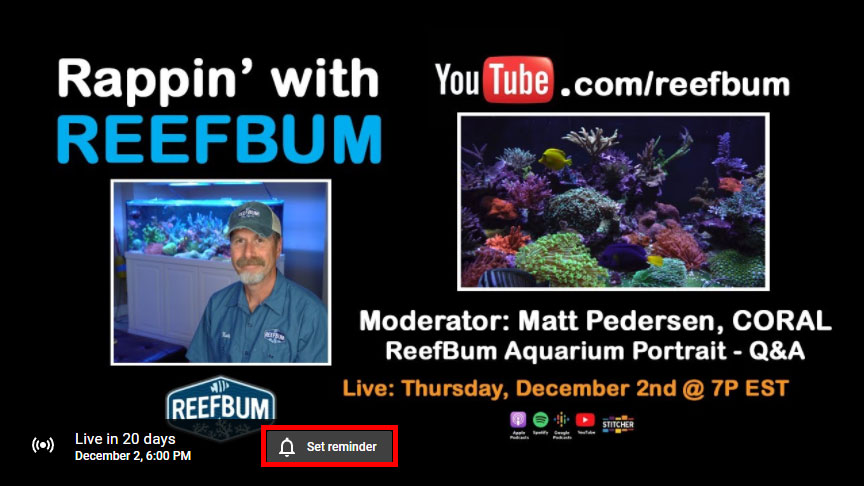
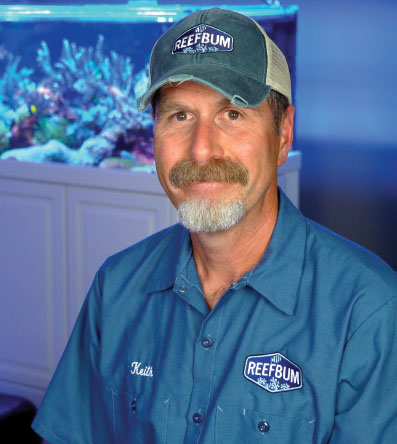





Trackbacks/Pingbacks